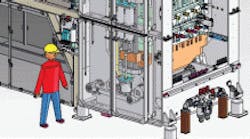Torque, Speed, and Yogurt Cups
Two servomotors will drive a single shaft in what’s billed as the world’s largest trim-in-place thermoforming machine.
The thermoformer, dubbed the FT14k, recently went to work for a company molding yogurt cups at a 140 cups/cycle rate. It incorporates an allelectric dual-action press designed to turn out cups, trays, or plates. Cycle time ranges from 10 to just a few seconds, depending on whether deep drawing is involved. The developer is Thermoforming Systems LLC, Union Gap, Wash.
Galil Motion Control Inc. Thermoforming Systems LLC (TSL) Yaskawa Electric America, Inc. |
Much thought went into the arrangement for moving the 7,500-lb platens. Two 30-kW servomotors drive each platen. Two more 15-kW servos handle the plug-assist function that aids in forming deep-draw features. Another 5-kW servomotor ejects parts after molding completes. The servos, all from Yaskawa Electric America Inc., Waukegan, Ill., are powered through Yaskawa Sigma II amplifier/controllers.
There are three motions involved in every molding cycle, and the machine inertia varies throughout two of them. Servomotors driving the platens are coupled through timing-belt pulleys and gearboxes to a driveshaft. The driveshaft works through a crank that generates a toggle motion and moves the platen up and down.
The toggle mechanism is nonlinear, starting with a high gear ratio initially, transitioning to a low gear ratio in the middle of the velocity profile. As the mold almost closes, the mechanism again switches back to a high gear ratio to deliver 382 tons of clamping force.
TSL developers say the dynamics of the drivetrain posed a challenging design problem. The two servomotors moving the platen had to share torque and not fight each other while driving the load. The initial approach was to designate one servo as a master axis with the other as a slave. But the master ended up handling a significantly larger portion of the load.
TSL worked with Galil Motion Control Inc., Rocklin, Calif. to arrive at a solution. It came in the form of a Galil DMC2280 motioncontrol board. A control feature called gantry mode allowed control of the two axes with neither one experiencing any windup as they worked together. Torque is now split evenly (within 1%) between motors.
The Galil board also controls the motor moving the plugs. The plugs move via a 1-in.- lead/rev ball screw driven by a servo running at high speed to minimize mold cycle time.
TSL also devised special high-speed air valves to get enough air flow into the mold to form parts quickly. Simulations and CFD studies resulted in a valve that transitions from fully closed to fully open in 50 to 70 msec and which delivers flow rates of over 200 cfm.
